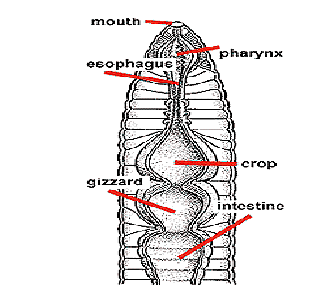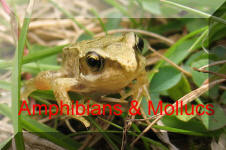Common Earthworm Lumbricus terrestris
BACK TO
VISIT THIS GALLERY OF WORMS Earthworms help to fertilise the soil by bringing nutrients closer to the surface.
Statistics
Earthworms vary in size from 90-300mm.Physical Description
Earthworms are made up of many small segments known as 'annuli'. These annuli are ridged and covered in minute hairs that grip the soil allowing the worm to move as it contracts its muscles. At about a third of the worm's length is a smooth band known as the clitellum. The clitellum is responsible for secreting the sticky clear mucus that covers the worm.Distribution
Earthworms are widespread in Britain and Europe. They have been introduced to most parts of the world.
Habitat
They live in soil at depths of up to 2m.Diet
Earthworms feed on decaying organic matter in the soil.

Behaviour
Earthworms move slowly underground feeding on decaying organic matter in the soil. They excrete digested material as worm casts and these can be seen as squiggly clumps of mud at the surface of the soil. These castings are very rich in nutrients because they contain minerals and nutrients that have been brought closer to the surface by the worms.
Reproduction
Earthworms are hermaphrodite and have both male and female reproductive cells. They cannot self-fertilise, however, and must find a mate to exchange sperm cells with. Earthworms reach sexual maturity at about four weeks old. This species comes to the surface to mate. Copulation, which may take up to an hour, involves two worms lying together with their heads pointing in opposite directions. While mating, the worms seem to shut out all other external stimuli and do not respond to light or touch. Large amounts of mucus are released by both individuals and while closely pressed against one another, sperm is exchanged. After this is complete the worms separate.
After mating the clitellum begins to secrete a substance which hardens to form a ring-like cocoon, into which the worm's own eggs and its partners sperm are placed. The 2mm cocoon eventually slips off the worm's head end and closes, becoming lemon-shaped. Fertilisation occurs inside the cocoon. This elaborate procedure is designed to prevent self-fertilisation.
Conservation status
Earthworms are not listed as endangered on IUCN Red
Worm Facts
It is a common belief if a worm is halved you will end up with two live worms. This is not true. If you chop a worm in half it is possible that one half may recover and heal but you are most likely to end up with two halves of a dead worm.Common earthworms (Lumbricus terrestris) are known in America and many parts of the world as 'nightcrawlers' and are frequently used as fishing bait
Lumbricus terrestris )Earthworms feed on partly decomposed organic matter in and on the soil, this is broken down further and after excretion the 'castings' are acted on by the soil micro-organisms. This means that the earthworm is an important part of the recycling of nutrients in the soil. Charles Darwin recognised their role saying, "It may be doubted whether there are many other animals which have played so important a part in the history of the world, as have these lowly organized creatures.". In addition their burrowing aerates the soil and improves drainage, helping other soil organisms and plant roots.
The worm casts contain higher levels of nitrogen, phosphorous and potassium than the surrounding soil - the products of digested organic matter and trace elements brought up from deeper levels. Calcium carbonate is also added and this can make acid or alkaline soils more neutral. This 'fertilizer' is distributed throughout the soil and research has shown that each worm can produce about 150g per year - much better than a dry or granular fast-acting chemical fertilizer which has no humus, leaches away and may repel the worms.
Earthworms usually dwell in the top few centimetres of the soil, but some species will go down nearly 2m. They need moisture to breath, and burrow deeper if the soil dries out or freezes. However, they will drown in waterlogged soil so the increasing periods of prolonged wet conditions may harm the population. They come to the soil surface at night when temperatures are lower and humidity higher. Most soil types are suitable except very acidic, and coarse sand.
They can reproduce when 3 - 6 weeks old, making a cocoon in the soil from which live worms emerge. The common view that cutting a worm in half makes two is not true, they can regenerate body parts in some cases, but usually both parts die.
Unfortunately the worm population of Northern Ireland and Co Down in particular, is under great threat at present from the New Zealand Flatworm. This interloper feeds exclusively on earthworms and can reduce the numbers to below detectable levels in the right conditions.
To increase the worm population, adding organic matter provides food and adding lime to acidic soil will help. They are said to like mint and planting it is supposed to attract them to the area. The brandling worms sold as fish bait are not suitable as they need the warmth of the wormery, although one of our 'famous' garden designers was shown adding them to one of his creations recently - they would have died off after a few weeks.
Some people, Eg greenkeepers, do not welcome the worms because of their 'casts' which spoil the perfect playing surface they are trying to achieve. A top-dressing of coarse sand has been shown to reduce the production of casts - I suppose they don't like eating sand or abrading their skin on it, any more than we do! An application of about 4cm split over three to four months should have some effect, ie. six or seven x 0.5cm every two weeks.Earthworms have no eyes and no brain, so they cannot 'see', but strong daylight can kill them. Their bodies are scattered with light-detecting cells connected to nerves that make the worms react correctly when they come to the surface. This attention to light is called phototropism. Some kinds of worm have eyespots on their heads and so can tell which direction the light is coming from.


